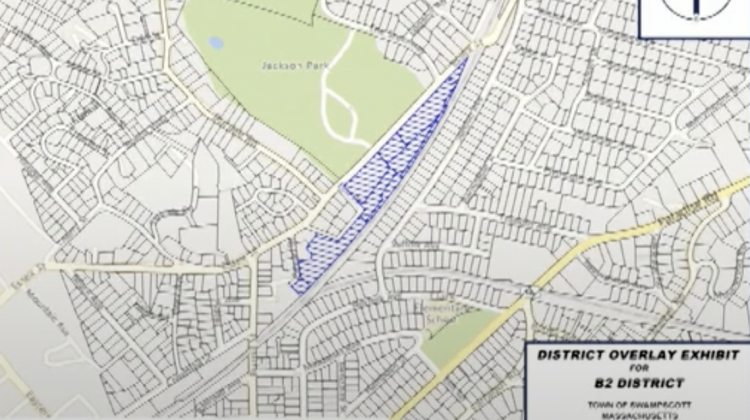SWAMPSCOTT — In a presentation to the Select Board, Planning Board member Angela Ippolito mapped out the proposed overlay districts that aim to bring the town in accordance with the Commonwealth’s MBTA Communities law.
Under Section 3A of Massachusetts’ 2021 Zoning Act, MBTA communities, or municipalities located half of a mile from an MBTA Commuter Rail, subway, or bus station or ferry terminal, must have a multi-family housing zoning district near the public-transit station. As Swampscott has a Commuter Rail station, it is considered an MBTA community and is required to create a multi-family housing zoning district by the end of 2024.
When the Commonwealth updated its Section 3A guidelines in August 2022, Ippolito said the amended guidelines reduced Swampscott’s minimum multi-family housing zoning requirement from 50 acres of land to only 20 acres, mandating that five of the 20 acres are close to its Commuter Rail station.
Further updates to Section 3A allow municipalities to overlay multi-family housing districts onto pre-existing multi-use zones. With this update, Ippolito said the Planning Board and Zoning Board of Appeals were able to map areas of Vinnin Square, which was zoned for use as a mixed-use commercial and residential district this year, for Section 3A.
Additionally, Ippolito presented a proposed 6-acre MBTA housing district surrounding the Commuter Rail station. The proposed districts in town, she said, already exceed Section 3A’s multi-family unit requirements.
“The news is that Swampscott is already in compliance,” Ippolito said at the Select Board’s meeting Wednesday night.
With the town’s current zoning bylaws already in compliance with Section 3A zoning, Ippolito said the town would not have to remove its current zoning bylaws or develop any multi-family residences, but merely vote — through the Select Board and later at Town Meeting next year — to create the overlay district.

“We can implement the 3A zoning and we can still encourage the mixed-use zoning. We can still encourage 15 units an acre by right; however, we’re in compliance already. We still have to comply with the bylaw and write the zoning. But that was all to explain why we are keeping the original zones that we had, even after the state updated their guidelines,” Ippolito said.
In response to Ippolito’s presentation, Select Board Vice Chair Katie Phelan applauded her and the ZBA’s efforts toward MBTA zoning amid the Commonwealth’s myriad guideline changes.
Phelan also noted that the Planning Board’s proposed districts exceed the state law’s requirements, and commended the board for viewing the state’s law as “a floor, not a ceiling.”
“I appreciate that you’re well above compliance. You didn’t just stick with the bare minimums of the requirements of the law,” Phelan said. “We all know that there is a housing crisis and there is an affordable-housing crisis happening, not just in our town but across the Commonwealth, and you didn’t just stick to the minimum gross density, you allowed for an opportunity greater than that.”
Select Board Chair David Grishman echoed Phelan’s comments, adding that the proposed bylaw would, even if it’s indirect, help create more affordable-housing options in Swampscott by creating a more diverse housing market.
“We’re in such a supply and demand imbalance within the Commonwealth of Massachusetts, specifically Eastern Massachusetts and the greater Boston area,” Grishman said. “Anything that we can do from a zoning perspective to generate new housing opportunities is going to help with affordability, even if it’s not 100% affordable or just 25% affordable.”
The Select Board agreed to review the proposed zoning districts in further detail next month.

